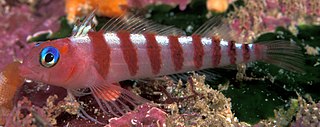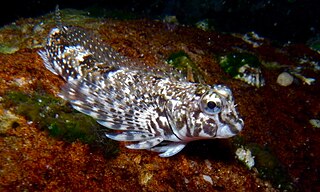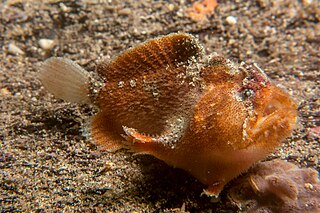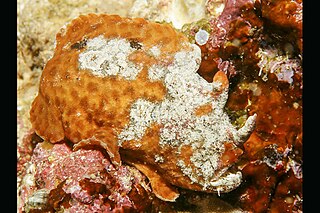
Combtooth blennies are blenniiformids; percomorph marine fish of the family Blenniidae, part of the order Blenniiformes. They are the largest family of blennies with around 401 known species in 58 genera. Combtooth blennies are found in tropical and subtropical waters in the Atlantic, Pacific and Indian Oceans; some species are also found in brackish and even freshwater environments.

Blenny is a common name for many types of fish, including several families of percomorph marine, brackish, and some freshwater fish sharing similar morphology and behaviour. Six families are considered "true blennies", grouped under the order Blenniiformes; its members are referred to as blenniiformids. About 151 genera and nearly 900 species have been described within the order. The order was formerly classified as a suborder of the Perciformes but the 5th Edition of Fishes of the World divided the Perciformes into a number of new orders and the Blenniiformes were placed in the percomorph clade Ovalentaria alongside the such taxa as Cichliformes, Mugiliformes and Gobiesociformes.

Pholidae is a family of marine ray-finned fishes, known as gunnels, in the scorpaeniform suborder Zoarcoidei. These are fishes of the littoral zone and are mainly found in North Pacific Ocean, with two species found in the North Atlantic Ocean and Arctic Ocean.

Helcogramma is a genus in the triplefin family Tripterygiidae. The blennies in the genus Helcogramma are found throughout the Indo-Pacific and in the South Atlantic Ocean off the islands of St Helena and Ascension.

Notoclinops is the name of a genus of triplefins in the family Tripterygiidae from New Zealand.

Pterygotrigla is a genus of genus of marine ray-finned fishes belonging to the family Triglidae, the gurnards and sea robins, one of two genera belonging to the subfamily Pterygotriglinae. These gurnards are found in the Indian and Pacific oceans.

Antennarius is a genus of anglerfish belonging to the family Antennariidae, the frogfishes. The fishes in this genus are found in warmer parts of the Atlantic, Indian and Pacific Oceans.

Tripterygion melanurum is a species of fish in the family Tripterygiidae, the threefin blennies. It is widespread in the Mediterranean Sea, where it occurs around the Balearic Islands and off the coasts of southern Sardinia, Algeria, Tunisia, Israel, Lebanon, Greece, Cyprus, and southern Turkey. It is a marine subtropical demersal fish measuring up to 5.3 centimetres (2.1 in) in length.
Enneapterygius ventermaculus, the blotched triplefin or Pakistan triplefin, is a species of triplefin blenny in the genus Enneapterygius. It was described by Wouter Holleman in 1982.

The eastern jumping blenny is a species of triplefin blenny in the genus Lepidoblennius. It was described by Franz Steindachner in 1867 and is the type species of the genus Lepidoblennius.

The scalyhead triplefin is a species of triplefin blenny in the genus Norfolkia. It was described by Allan Riverstone McCulloch and Edgar Ravenswood Waite in 1916. Under the synonym Norfolkia lairdi it was the type species of Fowler's new genus. This species has been recorded from off Queensland, Norfolk Island, Lord Howe Island, New Caledonia and the Loyalty Islands. The adults occur in tidal pools among areas of coral reef.

Echinophryne is a genus of marine ray-finned fishes belonging to the subfamily Histiophryninae in the family Antennariidae, the frogfishes. The fishes in this genus are endemic to the waters off Australia.

Fowlerichthys is a genus of marine ray-finned fishes belonging to the family Antennariidae, the frogfishes. The fishes in this genus are found the Atlantic, Indian and Pacific Oceans.

Phyllophryne is a monospecific genus of marine ray-finned fish belonging to the subfamily Histiophryninae in the family Antennariidae, the frogfishes. The only species in the genus is Phyllophryne scortea, the white-spotted anglerfish, smooth anglerfish or smooth frogfish, which is endemic to southern Australia.

Paratriacanthodes is a genus of marine ray-finned fishes belonging to the family Triacanthodidae, the spikefishes. These fishes are found found in the Indian and Pacific Oceans.
The visitor, also known as the sandpaper velvetfish,is a species of marine ray-finned fish, a velvetfish belonging to the family Aploactinidae. It is the only member of the monotypic genus Adventor. This species is found the Pacific Ocean waters along the coasts of Papua New Guinea and Australia.
The threefin velvetfish is a species of marine ray-finned fish, a velvetfish belonging to the family Aploactinidae. This species is found the western Pacific Ocean where it has been found on reefs. This species grows to a length of 5 centimetres (2.0 in) TL. This species is the only known member of its genus.

The whitenose pigfish is a species of marine ray-finned fish belonging to the family Congiopodidae, the horsefishes or pigfishes. It is endemic to the waters off southern and western Australia. It is the only species in the monotypic genus Perryena and the classification of that genus in the family Congiopodidae is not universally agreed upon.

Echinophryne crassispina, the prickly anglerfish, prickly frogfish or thick-spined anglerfish, is a species of marine ray-finned fish belonging to the subfamily Histiophryninae in the family Antennariidae, the frogfishes. These fishes are endemic to the temperate waters of southern Australia.
Pholidapus is a monotypic genus of marine ray-finned fishes belonging to the family Stichaeidae, the pricklebacks and shannies. Its only species is Pholidapus dybowskii which is found in the northwestern Pacific Ocean.


















